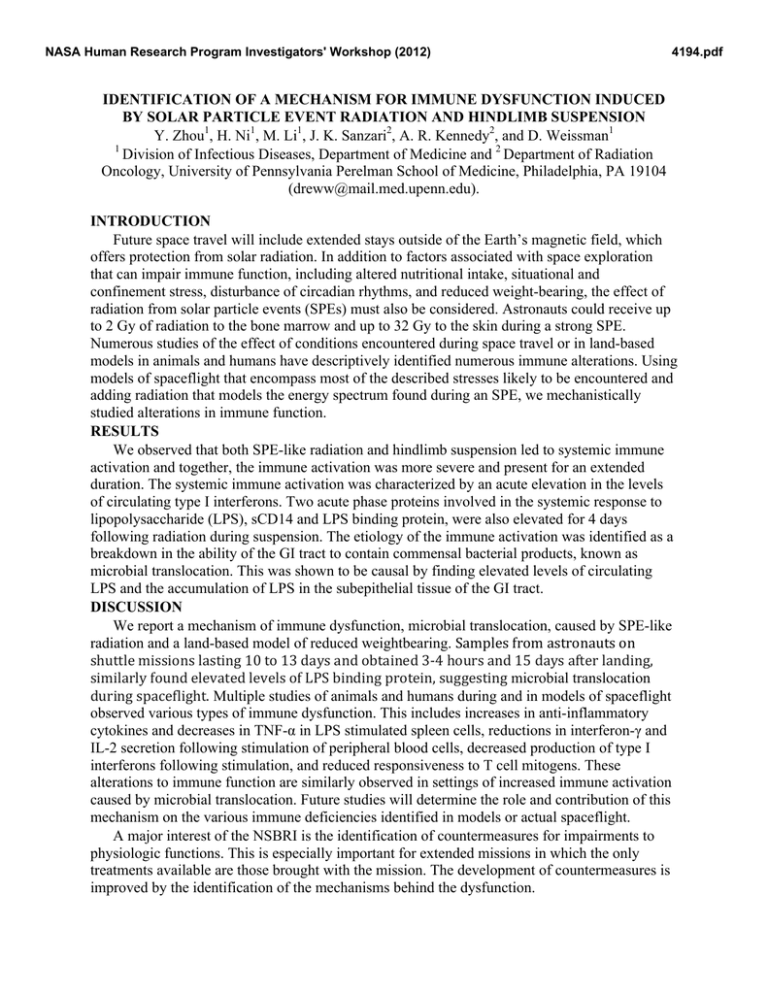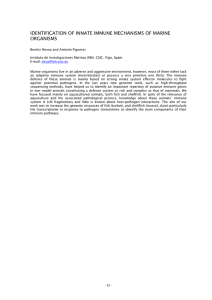IDENTIFICATION OF A MECHANISM FOR IMMUNE DYSFUNCTION INDUCED
advertisement

NASA Human Research Program Investigators' Workshop (2012) 4194.pdf IDENTIFICATION OF A MECHANISM FOR IMMUNE DYSFUNCTION INDUCED BY SOLAR PARTICLE EVENT RADIATION AND HINDLIMB SUSPENSION Y. Zhou1, H. Ni1, M. Li1, J. K. Sanzari2, A. R. Kennedy2, and D. Weissman1 1 Division of Infectious Diseases, Department of Medicine and 2 Department of Radiation Oncology, University of Pennsylvania Perelman School of Medicine, Philadelphia, PA 19104 (dreww@mail.med.upenn.edu). INTRODUCTION Future space travel will include extended stays outside of the Earth’s magnetic field, which offers protection from solar radiation. In addition to factors associated with space exploration that can impair immune function, including altered nutritional intake, situational and confinement stress, disturbance of circadian rhythms, and reduced weight-bearing, the effect of radiation from solar particle events (SPEs) must also be considered. Astronauts could receive up to 2 Gy of radiation to the bone marrow and up to 32 Gy to the skin during a strong SPE. Numerous studies of the effect of conditions encountered during space travel or in land-based models in animals and humans have descriptively identified numerous immune alterations. Using models of spaceflight that encompass most of the described stresses likely to be encountered and adding radiation that models the energy spectrum found during an SPE, we mechanistically studied alterations in immune function. RESULTS We observed that both SPE-like radiation and hindlimb suspension led to systemic immune activation and together, the immune activation was more severe and present for an extended duration. The systemic immune activation was characterized by an acute elevation in the levels of circulating type I interferons. Two acute phase proteins involved in the systemic response to lipopolysaccharide (LPS), sCD14 and LPS binding protein, were also elevated for 4 days following radiation during suspension. The etiology of the immune activation was identified as a breakdown in the ability of the GI tract to contain commensal bacterial products, known as microbial translocation. This was shown to be causal by finding elevated levels of circulating LPS and the accumulation of LPS in the subepithelial tissue of the GI tract. DISCUSSION We report a mechanism of immune dysfunction, microbial translocation, caused by SPE-like radiation and a land-based model of reduced weightbearing. Samples from astronauts on shuttle missions lasting 10 to 13 days and obtained 3-­‐4 hours and 15 days after landing, similarly found elevated levels of LPS binding protein, suggesting microbial translocation during spaceflight. Multiple studies of animals and humans during and in models of spaceflight observed various types of immune dysfunction. This includes increases in anti-inflammatory cytokines and decreases in TNF-α in LPS stimulated spleen cells, reductions in interferon-γ and IL-2 secretion following stimulation of peripheral blood cells, decreased production of type I interferons following stimulation, and reduced responsiveness to T cell mitogens. These alterations to immune function are similarly observed in settings of increased immune activation caused by microbial translocation. Future studies will determine the role and contribution of this mechanism on the various immune deficiencies identified in models or actual spaceflight. A major interest of the NSBRI is the identification of countermeasures for impairments to physiologic functions. This is especially important for extended missions in which the only treatments available are those brought with the mission. The development of countermeasures is improved by the identification of the mechanisms behind the dysfunction.





